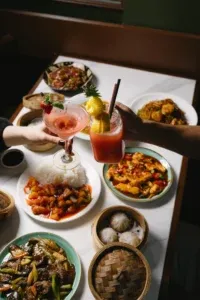Chinese Family Dining and Togetherness
Chinese family dining reflects tradition, respect, and love, turning every meal into a joyful moment of shared togetherness. It reflects family, harmony, and the joy of sharing. Therefore, every meal feels like an opportunity to connect. Moreover, families gather around a round table, passing dishes and stories with equal warmth. Ultimately, the act of dining becomes a tradition of togetherness that binds generations.
Chinese Family Dining Culture of Sharing
 In Chinese culture, meals rarely focus on individual plates. Instead, dishes sit at the centre for everyone to share. This style naturally encourages interaction. Every hand reaches forward, every bite becomes a collective experience. As a result, dining connects people more deeply than eating alone ever could.
In Chinese culture, meals rarely focus on individual plates. Instead, dishes sit at the centre for everyone to share. This style naturally encourages interaction. Every hand reaches forward, every bite becomes a collective experience. As a result, dining connects people more deeply than eating alone ever could.
The Symbolism of the Round Table
Round tables dominate Chinese dining spaces for good reason. Indeed, they symbolise unity, equality, and inclusiveness. Furthermore, nobody sits at the “head.” Instead, everyone faces each other. Meanwhile, the lazy Susan, often placed at the centre, allows dishes to spin easily. Consequently, this ensures fairness and balance, as no one is left out.
The Power of Collective Choices
When families dine together, they choose dishes as a group. From dim sum baskets to hot pot selections, decisions happen jointly. This creates conversations, compromises, and laughter. Even children gain a voice when choosing favourite flavours. Thus, meals become democratic moments, teaching values of respect and consideration.
Festivals and Feasts
Chinese dining shines brightest during festivals. Food plays a vital role in marking family milestones and cultural traditions. Every dish carries meaning, turning the table into a place of memory and celebration.
Lunar New Year Traditions
During Lunar New Year, families return home for the reunion dinner. This is one of the most important meals of the year. Dishes symbolise prosperity, health, and long life. Dumplings resemble ancient coins. Fish represents abundance. Noodles stand for longevity. Families exchange blessings with every bite, reinforcing love and unity.
Mid-Autumn Gatherings
The Mid-Autumn Festival also brings families together. Mooncakes, rich with fillings, are shared among relatives. Eating mooncakes under the full moon symbolises reunion and completeness. It is not just dessert. It is a cultural reminder of family wholeness, passed from one generation to the next.
Chinese Family Dining Beyond the Home
Togetherness does not stop at home. Chinese dining traditions extend to restaurants, banquets, and even street stalls. Families often gather outside to celebrate milestones such as weddings, birthdays, or graduations.
Banquets as Social Bonds
Banquets showcase the best of Chinese hospitality. Multiple courses appear in sequence, each reflecting thought and care. Guests share food, raise toasts, and exchange stories. Such meals strengthen family bonds while also reinforcing community ties. Every toast, every bite, reminds people of shared joy.
Hot Pot as a Social Experience
Hot pot is another perfect example of communal dining. Everyone cooks food together in a shared broth. Choices vary, but the act is always collective. The bubbling pot at the centre encourages conversation and laughter. Nobody rushes. Meals stretch for hours, strengthening both friendship and family ties.
Chinese Family Dining and Togetherness Lessons
 Chinese dining teaches simple yet lasting lessons. Above all, meals are about slowing down and making time for people who matter.
Chinese dining teaches simple yet lasting lessons. Above all, meals are about slowing down and making time for people who matter.
Respect Across Generations
Elders always receive food first. Younger family members serve them as a sign of respect. This gesture ensures traditions survive. Children watch, learn, and carry these values forward. Such customs preserve not only food heritage but also family harmony.
The Joy of Ritual
Every chopstick clink, every shared dish, and every toast forms part of a ritual. These small acts carry great meaning. They remind families that meals are not only for eating. They are for bonding, laughing, and celebrating life together.
Modern Times, Same Values
Even with fast-paced lifestyles, Chinese families keep dining traditions alive. Many still gather weekly despite work schedules. Restaurants adapt by offering family-style menus that preserve cultural habits. Modern life changes many things, but the value of togetherness remains central.
Food as a Bridge
Chinese dining also bridges distances. Families abroad recreate home meals to feel closer. A pot of congee or plate of dumplings brings comfort. It connects people across borders and generations. In this way, food continues to act as a bridge of love.
Conclusion: Together at the Table
Chinese dining embodies the spirit of family first. Moreover, through shared dishes and traditions, it reminds us of what matters most. As a result, every meal passes on values of respect, harmony, and care. Meanwhile, in a world that moves fast, the Chinese dining table offers something timeless. Ultimately, true richness lies not in the food itself, but in the act of eating together.